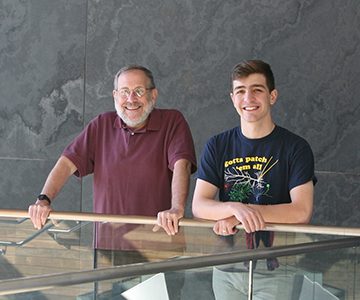Joshua Sanes (l) and Dimitar Kostadinov
The dendritic processes of neurons form elaborate branched arbors that are stereotyped among neurons of a specific type but differ markedly among types. It is reasonable to imagine that the form of an arbor influences the neuron’s function, but this idea has seldom been tested experimentally. To perform such a test, Kostadinov and Sanes focused on two aspects of arbor geometry: the ability of dendrites in some neurons to avoid other dendrites of the same neuron (self-avoidance) while interacting freely with dendrites of neighboring neurons of the same type (self/non-self discrimination). They analyzed a neuronal type in retina called the starburst amacrine cell (SAC). The function of SACs has been well-established: they detect directional motion and transmit this information to other SAC dendrites and to direction-selective ganglion cells, which send this information to the brain for further processing.
In a previous study (Lefebvre, Kostadinov et al., Nature, 2012) they had found that both self-avoidance and self/non-self discrimination in SACs are controlled by a set of 22 genes called gamma-protocadherins (Pcdhg’s). Specifically, removing Pcdhg’s disrupts self-avoidance, leading to dendrites that cross over each other frequently. In contrast, removing 21 of the 22 Pcdhg’s, and leaving the same one in all SACs disrupts self/non-self discrimination. They had explained these results as follows: Pcdhg’s are homophilic recognition molecule – that is each type binds to other Pcdhg’s of the same type well but to the other 21 poorly if at all. These interactions lead to repulsion. Each SAC expresses a small random subset of Pcdhg’s, Because all dendrites (or axons) of a single neuron display the same set of Pcdhg isoforms, they exhibit self-avoidance. On the other hand, any individual neuron is unlikely to encounter a neighbor that displays the same combination of isoforms, so the neurons do not repel each other, and thus display self/non-self discrimination.
The genetic methods Lefebvre and Kostadinov developed in their initial sty study gave them a way to disrupt self-avoidance and self/non-self discrimination in SACs. Kostadinov then recorded from SACs and DSGCs to assess the consequences of these manipulations. When he recorded from pairs of SACs, he found that SACs lacking all Pcdg’s, and thus defective in self-avoidance, still form synapses with each other but now additionally form synapses with themselves. It was as if they mistook sibling dendrites for those of their neighbors. In contrast when SACs all expressed the same single Pcdhg, and thus lacked self/non-self discrimination, they formed few connections with each other and none with themselves. It was as if they mistook neighboring for sibling dendrites. Interestingly, perturbing either process degraded directional computation by DSGCs without affecting the strength of connections to or from the SACs. Together, these results provide the first insights into how self-avoidance and self/non-self discrimination help set up neural circuits.
Read more in eLife or download PDF


